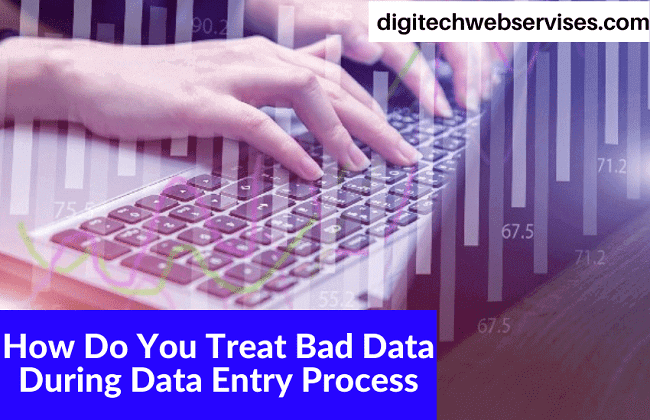How Do You Treat Bad Data During Data Entry Process?
Do you know bad data costs companies nearly $13 million every year? And almost 60% of businesses have no statistics to tell how much loss they suffer because of erroneous data, as per a Gartner Survey.
Data entry systems are the foundations of enterprises involved in data management processes, like BPOs. But, there may be numerous errors or mismanagement if you do it manually. Because of that, entrepreneurs feel as if it’s not important for businesses. Error detection and fixing require more money, which is an additional cost.
Automation can prevent that cost burden. You can transform your data entry system completely by automating data entry, processing, storage, and management effectively.
What is Bad Data?
Table of Contents
The inconsistent, typos, duplicates, missing & decaying entries, formatting errors, and non-normalized data refer to poor or bad data.
To remove such errors, data processing and management should be properly executed. Data cleaning, enrichment, appending, and normalization are a few subsets that define the quality of data. With quality data entry in a fast turnaround time, it’s way easier to draw insights and analyze for drawing breakthroughs.
Risks Associated with Poor Data Quality
The first and foremost risk is a financial loss. Bad data together with obsolete records can minimize the inflow of leads and inquiries. Email campaign results may not be satisfactory because of the bad quality of leads.
For administration, the back office management would be weak because of little to no knowledge of the efficiency of staff members and the organization’s productivity. It can negatively impact your business revenues and reputation. Over time, they both come down if remain unnoticed.
Bad Data Makes Marketing & Sales a Big Challenge
Here are four main problems that your marketing team may face because of erroneous data.
-
Possibility of getting blacklisted
Since the advent of digital marketing, it’s way easier to reach out to a wider audience. Simultaneously, it’s not easy to maintain your online reach, traffic, and communication with customers consistently. It’s where data appear in a leading role.
What if your list of email IDs has incomplete data or bad data?
Certainly, you would pay for sending all contacts that are on the list, no matter if they are accurate or wrong. This can put an extra burden on the amount that can be used to email the relevant and complete email ID users.
In addition, invalid email IDs would be recognized as spam emails (because of inaccurate email IDs). If it consistently happens, your account can be blacklisted or even, suspended by the email service provider. Now, you can imagine how worse it can be for your company’s name & reputation.
-
Increased email churn
Email churn rate refers to the percentage of subscribers who left your list of contacts over time. It ends up minimizing customers.
Simply put, those who were your consumers are no more your customers. This dropout would result in a major loss. Your business relations would be adversely impacted.
-
Prospects and customers get the wrong content
There is a key role of content in this type of marketing. You often share solutions to your customers’ problems upon thoroughly examining the buyer’s journey. It automatically displays where they faced the problem.
What if you contacted the wrong person (who is not aligned with your email list) for providing a solution via a newsletter or personalized message?
Such silly mistakes often lead to bad customer experience, which degrades your brand reputation.
-
Buyer personas don’t hold up
During brand awareness, the key is to reach out to the right person who is interested in your products or services.
It won’t do any good if you fail to analyze the right buyer’s persona. Certainly, inaccuracies will be responsible for it. False information can result in missed opportunities for generating revenues.
-
Inaccurate data wastes sales reps’ time
Having a list of contacts of prospects won’t convert them into consumers. With an accurate contact number, you can have many opportunities in your account.
Many call representatives feel that patchy, inaccurate, missing data are responsible for less conversion rate. There should the practice of data hygiene and maintenance before sending the list to telecallers for cold calling or supporting customers.
Poor data quality can produce bad experiences for customers, prospects, and your team
Have you seen the impact of saying “Hi” and “Hi Steven”?
Both are salutations. But, the second example shows a more personalized approach. Now, consider another case wherein you make a mistake in the name of the customer or send an email with another user’s name.
This mix-and-match misspelled names, and duplicate messages are bad data examples. The data entry process focuses on minute to bigger mistakes for preventing any wrong message. It casts a negative impression,
How to Improve Data Quality
Here are a few best practices that can be helpful in dealing with bad data.
-
Assess and improve data collection methods
Emphasize auditing every source, tool, or method that is used in collecting or making data entries in your system. These sources can be internal or external. Let’s catch up with more precise practices to prevent bad data.
-
Align web forms
These are really effective in communicating with customers directly and requesting for submitting their own contact details. So, it’s indeed a valuable data repository, which is connected to your official email ID and CMS. You may also get a range of data sets through content downloads, blog subscriptions, webinar registration, or referrals.
-
Contact authentic third parties
To deal with second or third-party data discrepancies, focus on gathering databases from authorized and reputed data vendors. Audit all records thoroughly before saving them on your own server.
-
Minimize manual data entry
Switch to Google spreadsheet or doc files for automating data entries. Create master data to automatically align that list as-is to your sales and marketing teams.
However, errors are unpredicted. There can be any reason for causing erroneous data. But, this problem can be minimized by scheduling data cleansing, appending, and enriching data on a regular basis.
-
Work with a market intelligence provider
You may hire BPOs that provide quality data for boosting sales and marketing. This can be the best option for SMEs that have to manage everything on a small budget.
They also help in analyzing your database and determining issues if there are any so that you can boldly go ahead to make data-driven decisions.
-
Rely on Expert gig partners for high-quality
The gig economy is booming these days and this trend will continue till the end of the 2030s. So, you have a great opportunity ahead. Just hire a gig partner. Get his support in fixing any errors or inconsistencies in your sales or marketing or any other databases.
Ensure to check if he is certified, experienced, and trained. Ask for a few demos, or you may request a pilot project to estimate how good he is. Later on, check the consistency, accuracy, and quality of data. Lastly, negotiate the price.
Summary
The cost of having bad data running through your system far outweighs the cost of introducing good data to your business. When it comes to critical business data, don’t simply look at the price tag, consider the return on investment in high-quality data and the time and money you could lose by making the wrong choice.



